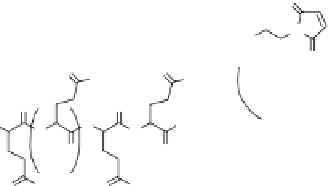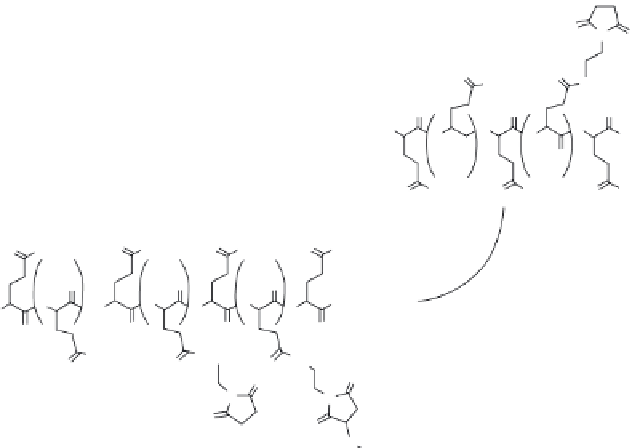Biomedical Engineering Reference
In-Depth Information
Another strategy for selectively improving cell adhesion on PEM films is to graft pep-
tides that are known to interact with specific cell adhesion receptors. Basically, the idea
underlying this strategy is similar to the previous one except that the method is different:
here, only short sequences of the ECM proteins are considered and have to be covalently
grafted to one of the polyelectrolyte. This requires first a synthetic chemistry step. The
most prominent example is that of the RGD sequence. Hersel et al. reviewed the consid-
erable number of strategies that have been developed to immobilize RGD on polymers,
RGD being a central integrin-binding region in FN and COL. Using PEM, a new strat-
egy consisted of grafting the peptide to one of the polyelectrolytes and then adsorbing
the modified polyelectrolyte as a regular layer. PEM films exhibiting a poor adhesion are
excellent candidates for such functionalization, which was applied using PAH-RGD and
PGA-RGD for cell attachment (Berg et al. 2004; Picart et al. 2005a). Thus, the grafting of
a 15-amino acid peptide containing the RGD motif (Figure 8.7) increased significantly
the initial adhesion of primary osteoblasts onto PLL/PGA films. Interestingly, both film
cross-linking and peptide grafting had an effect on the adhesion that could be poten-
tialized when combined together (Picart et al. 2005a). Recently, in an elegant work by
Werner et al. (2009), it was shown that a laminin-5-derived peptide grafted to PGA could
induce specific cell adhesive structures in epithelial cells called hemidesmosomes and
activate
β
4
integrins. Using a different strategy, HA/CHI films onto which cells adhered
poorly were rendered adherent by functionalization with an RGD containing peptide
using carbodiimide chemistry (Chua et al. 2008). The immobilized RGD was shown to
have a beneficial influence on osteoblast adhesion and proliferation. Other peptides, such
O
O
N
N
O
PGA−Mal
TFA, H
2
N
O
O
O
O
O
PGA
OH
OH
OH
NH
O
O
O
O
O
N
N
N
H
2
N
OH
H
2
N
H
H
OH
H
H
EDC, SulfoNHS
HEPES Bu
er
pH 6.5, 24 h, rt
O
O
O
O
m
n−m
n
O
O
OH
O
OH
OH
O
OH
O
OH
HEPES Bu
er
pH 7.4, 24 h, rt
O
OH
O OH
m
O OH
O OH
n−m−p
P
(ii) HS
RGD15m
O
O
O
N
N
N
OH
H
H
NH
H
(ii) HS−CH
2
CH
2
COOH
H
2
N
O
O
O
O
OH
NH
O
O
O
O
CGPKGDRGDAGPKGA
from human collagen I
O
N
N
PGA−RGD15m
O
O
S
S
RGD15m
CH
2
CH
2
COOH
FIGURE 8.7
Scheme of synthesis of 15-amino acid peptide that contained a -RGD- sequence (PGA-RGD15m). In a first step,
PGA was conjugated to maleimide groups (PGA-Mal). Then, conjugated PGA-Mal was mixed with PGD15m
peptide. Mercaptopropionic acid was used to neutralize unreacted maleimide groups. Final product con-
tains thus both RGD function and carboxylic sites that have a polyelectrolyte character. Grafting ratio was
10%. (Reproduced with permission from Picart et al.,
Adv. Funct. Mater.
, 15, 83-94, 2005a. Copyright Wiley-VCH
Verlag GmbH & Co. KGaA 2005.)

















Search WWH ::

Custom Search